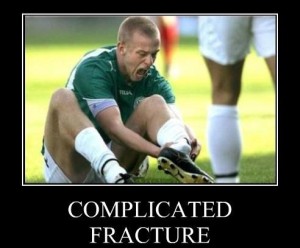Complicated fractures are broken bones or fragments
of a broken bone which causes damage to surrounding tissues, major blood vessel, or even organs. This is why, as their names suggests, it is complicated in nature. The damage to the other organs is usually due to bone penetration through these organs. This commonly occurs in the chest or abdominal region, when the ribs go through the organs it was initially protecting. Complicated fractures need immediate treatment as they can prove to be life-threatening to the person who suffers them.
Causes of Complicated Fractures
As is the case with all fractures, complicated fractures usually occur as a result of direct blow by high-energy trauma of an outside force on the bone. When this force is stronger than the bones, it results to a closed fracture. Some of the cases where force is greater than the bones are the following:
- High speed motor vehicular collisions or accidents
- Sports injuries, most especially those involving stunts
- Falls
- Sometimes, certain conditions and disorders of the body weaken the bones in the body, increasing risks for closed fracture, such as:
- Osteoporosis
- Cancer
- Indirect force
- Abnormal muscular contraction
To avoid these fractures, always take the necessary extra precaution, such as wearing seatbelts and other protection for the bones.
Signs and Symptoms of Complicated Fractures
It may often be hard to tell whether the victim has suffered a complicated fracture or a closed fracture. However, aside from the typical symptoms of fractures, complicated fractures have additional signs and symptoms which help determine the severity of the fracture.
- Nerve damage
- Difficulty or incapability of moving fingers or toes
- Loss of sensation
- Lung damage
- Difficulty breathing
- Coughing up blood
- Organ damage
- Pain in soft lower torso reign
- Blood coming out from the mouth
- Others
- A breaking or cracking sound heard or felt
- Bruising and swelling on and/ or around the site of the injury
- Severe pain
- Internal and external bleeding
- Deformity
- Nausea
- Shock
- Cyanosis of the skin and tips of fingers and toes or discoloration
First Aid for Complicated Fractures

- Do not attempt to move the victim unless there is imminent danger in the area, especially if suspected of head, neck, spinal, ribs, pelvis or upper leg fracture.
- If there is bleeding, try and cease the bleeding by applying direct pressure on the wound using a clean absorbent cloth or bandage. If the cloth becomes soaked in blood, put another piece of absorbent cloth on top of old cloth to avoid disturbing the wound. Once controlled, cover with a clean dressing.
- Immobilize the injured area. Do not attempt to push back the bone that’s visibly sticking out or misplaced. If one is trained to apply splint, apply a splint above and below the fractured area. Pads may be added to reduce discomfort.
- Check for symptom of shock and treat if necessary.
- If there is no pulse or respiration, commence CPR.
Complicated fractures should be given immediate treatment and medical care as soon as possible as internal damage may be more severe than its external counterpart. To learn how to give first aid for complicated fractures and other types of bone injuries, enroll in First Aid Training.
